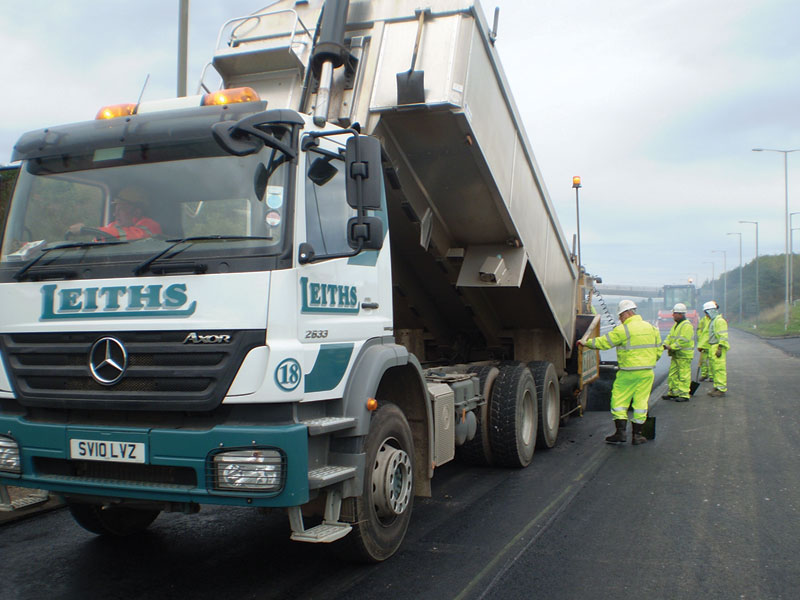Scotland’s Asphalt Surface Course Specification

First published in the January 2014 issue of Quarry Management as Take the High Road
Have Scottish roads taken the lead in the UK durability stakes? One road builder north of the border claims the case is compelling for using Scotland’s surface-course specification in place of the English version
Stone-mastic asphalt thin-surface course systems (TSCS) have been getting a poor press of late due to surfacing failures around the UK, often due to poor laying practice and/or bad weather. Other factors may include high void and low binder content within the asphalt, deficiencies which are addressed in TS2010, the Scottish surface course specification. This document thereby ensures a more durable material, its proponents say, than the prevailing UK standard, Clause 942 of the Specification for Highway Works.
‘It stands to reason that increasing binder content and reducing voids will inevitably lead to material with greater durability,’ commented Neil Anderson, technical director of Aberdeen-based Leiths Group. Referring to recent tests on resurfaced sections of the A90 in Scotland (see next page), he said: ‘These indicate that following an approach to asphalt mix made possible under the Scottish specification would give considerable benefits to roads throughout the UK.’
The differences in the two specifications are significant. Clause 942 currently requires TSCS to have BBA HAPAS certification applicable to the traffic level and site classification specified. The Scottish system does not call for these certificates. Clause 942 requires compliance with a certain level of wheel tracking and texture; certain aggregate physical properties are specified; and other properties are referred to a contract-specific appendix. A performance guarantee of five years is required unless otherwise specified in this appendix. The BBA HAPAS requirements can also apply to the same product type made in different quarries.
TS2010 (soon to be renamed Clause 942TS) is much more prescriptive than the English system and specifies a polymer-modified binder, a grading and binder envelope, and an air-void content of the finished product. It also specifies thickness requirements, the use of fibre, resistance to deformation, and early-life skid resistance as measured by a GRIP tester. Each quarry requires a separate approval for each mix type.
The premium polymer-modified binder specified is intended to ensure that asphalt mixtures in which it is incorporated are serviceable over a wide range of temperatures. This type of binder provides deformation resistance while additionally providing improved resistance to cracking in low temperatures.
The Scottish specification also requires a four-stage Type Approval Installation Trial (TAIT) for each product used. The Notes for Guidance given as part of TS2010 also form an integral part of the specification and give important guidance on a number of issues, such as the choice of material sizes for geometry or stress expected.
Early-life skid-resistance requirements have now been adopted for TS2010 with levels set higher than the requirements set out in HD36/06 of the Design Manual for Roads and Bridges; and with a declared polished stone value (PSV). ‘There is an opportunity with TS2010 to use local aggregates – a more sustainable option – which may have previously been precluded by using HD36/06’s Table 3.1,’ said Mr Anderson.
An interesting part of the Scottish process is the testing of the surface to determine skid resistance. Collating results from different types of surfacing will allow the specifier to consider different types of material. By using certain aggregates and mix designs it may be possible to produce thin-surfacing mixes that have inherent designed skid-resistance properties approaching those achieved by high-friction surfaces – used extensively in the UK for a number of years and generally only with a life of five to 10 years.
A9 resurfacing project
‘On the recently completed A90 trunk road resurfacing project near Aberdeen the contract called for a Clause 942 thin surfacing using a polymer-modified binder and a nominal 10mm aggregate laid to a nominal 30mm thickness along a 2.5km stretch of road,’ said Mr Anderson.
Aggregates had to have a minimum PSV of 55, a maximum aggregate abrasion value (AAV) of 14 and a flakiness index (FI) of 20. Wheel tracking level 3 and road/tyre noise level 1 were specified along EME2 support layers for the surfacing, together with a performance guarantee of five years.
‘Two sections of the new construction required a higher PSV of 68 – however, higher-PSV aggregates tend to be less durable than lower-PSV mixes when used as thin surfacings,’ said Mr Anderson.
Leiths offered an alternative; a material that would meet all of the contract requirements plus also meet TS2010. ‘It was decided to proceed with two stone-mastic asphalt (SMA) mixes (10mm and 6mm) using local granite aggregates of PSV 56, laid to a target thickness of 35mm,’ said Mr Anderson. For the polymer-modified bitumen Leiths used Nynas Nypol 103, a highly modified elastomeric binder which demonstrates substantial resistance to deformation and cracking.
To comply with TS2010, TAIT stages 1 and 2 were completed, involving laboratory mix designs and production and laying trials. Deemed satisfactory, the material was laid on the A90 for a trunk road network trial. Transport Scotland insists on best-practice installation of materials, including the keeping of training records of all operatives involved.
Extensive tests of the laid material included taking nuclear density-gauge readings every 20m in alternate wheel tracks to check in-situ density compliance. Voids were found to comply with the specification. A GRIP test was carried out immediately after the contract was completed and values greater than 0.7 (0.62 Scrim) were achieved. This was a greater skid resistance than required by the contract, and higher than the 0.55 Scrim level required for a Class 3 site.
On the A90 project, 6mm SMA was laid in the areas of junctions where a greater degree of skid resistance was required. A PSV test of the aggregate fraction used in this layer gave results of 73. The early-life skid resistance values of the 6mm surfacing proved marginally higher than the 10mm surfacing made with the same aggregate type.
‘Recent studies have shown that a 6mm mix will retain higher levels of skid resistance when compared with larger aggregate mixes. Research in Scotland has shown that smaller aggregates yield higher skid resistance regardless of PSV and also have better skid resistance at higher speeds,’ said Mr Anderson.
Further GRIP testing will be carried out in six months’ and two years’ time.
Mr Anderson concluded: ‘Given the higher binder contents specified and the void content required, this type of product must be more durable than a standard Clause 942 material. I believe many failures of thin surfacing are directly attributable to high void and low binder content.
‘Given that exactly the same plant and labour resources are utilized to manufacture and lay a Clause 942 material compared with a TS2010 material, the case for following the TS2010 specification and producing a more durable material is compelling. The use of GRIP testing also brings performance testing to a new level.’
- Subscribe to Quarry Management, the monthly journal for the mineral products industry, to read articles before they appear on Agg-Net








